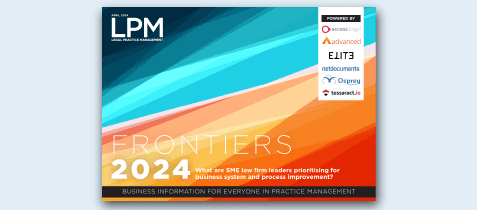Contents
Best practices for setting the right pricing model and boosting profits from a costs lawyer
In this conversation, Lynsie Whyke – costs lawyers, draftsman, and previous law firm office manager – considers how law firms can achieve success and boost profits by implementing the right pricing model
Lynsie Whyke, founder of Chantry Costs Consultants who help solve legal costs, fees and pricing issues for law firms, joined me to share her two decades’ expertise and insights on how SME law firms can maximise profits and run a successful law firm by scoping, pricing, recording time, and charging clients effectively.
In this conversation we cover:
- How to manage pricing and costing effectively
- The best practices for scoping a case and how to avoid ‘scope creep’
- How to record time more accurately
- The importance of knowing your worth and how to charge accordingly
Top three things all fee earners and management should know about managing pricing and costing effectively
Lynsie believes there are three ways to achieve effective pricing and costing: –
- Don’t price through fear
“The cost process needs to be treated as a way to build engagement with clients. It isn’t just about money – it’s also about learning and getting to know the client and how you can add value.
- Spend more time on scoping
“Most fee earners don’t give enough time. Spend more time in the beginning to save you time in the long run,” Lynsie advises.
- Avoid complaints
“The amount of complaints firms receive about pricing is crazy – and are mostly avoidable. It’s about having open and honest conversations, spending the time getting the price right first and then more time doing the work that you love – without worrying about price.”

About Lynsie Whyke
With over 20 years’ experience as a costs lawyer, Lynsie’s legal career began at Irwin Mitchell Solicitors; she then managed offices for both MRN Solicitors and Just Costs Solicitors before establishing Chantry Costs Consultants in 2012.
Lynsie prides herself on working closely with clients to provide advice on costs issues and maximising their costs recovery. She has helped numerous clients by providing accessible, practical training and consultancy services to help them understand their value and optimise their costs.
Four best practices for scoping a legal case
Lynsie outlines her approach to scoping out a case to ensure that value for both you, the firm, and the client: –
- Breakdown fees into sections or phrases – assign fixed fees
- Identify what you need to know and ask the right questions at the beginning so that you can price more accurately
- Outline for the client what the work does and doesn’t involve to set clear expectations
- Consider the client synergies – potential difficulties or issues may need to be factored into the cost
Lynsie emphasises: “There’s no rule that says you have to give a fee for the entire process. So, if you don’t know what’s going to happen at a certain point, don’t give your client a quote beyond that stage.”
Where fee earners are relatively new to scoping a case, Lynsie advises to “spend a few minutes before you have that conversation with your client. Work out what you actually need, and what information you need from the client, in order to give an accurate price. If they want to know from you the price before they’re giving you any information, that’s a little bit of a red flag, and potentially not the sort of client that you really want to work with.”
Advice for avoiding scope creep in a legal matter
Scope creep can occur in three different areas: client requests, case requirements or through the effectiveness of the management of the case.
To avoid scope creep in your cases, Lynsie recommends: –
- Documenting the standard stages of a case so all actions are considered for costing. Sometimes the process is such a habit for the lawyer that rudimentary, everyday tasks are missed from the scope.
- Set up a system that highlights when work is out of scope at the earliest opportunity.
- Set expectations for clients at the start and highlight any changes in scope and cost early to agree next steps.
- Be transparent on price. Clients don’t like surprises.
Sometimes scope creep, or additional required actions on a matter is unavoidable, but to make the process of discussing price easier, it’s important to set expectations for the client at the initial enquiry phase. Setting expectations will outline what the current quote covers and what it doesn’t, this will make discussions about associated costs easier to have. Lynsie advices solicitors to: – “Identify that you’re stepping outside your scope at the earliest opportunity. You don’t wait until you’ve done the work and then go back and have a conversation with the client, hoping they might want to pay you a little bit extra for that work.”
How to time record more effectively to increase billable hours
According to LPM’s 2024 Frontiers report, SME firms primarily use the billable hour model to price a case and so, time recording is a crucial factor in billing clients accurately. But a common complaint among law firm clients is their bill being higher than the original quote.
Time recording is often not accurately recorded and therefore doesn’t enable accurate forecasts or bill estimates. Lynsie explains there are three reasons why time recording isn’t accurate: “Firstly, lawyers aren’t often utilising their case management software as well as they could, and the [second] problem is that they’re so busy with their day, they simply forget.”
But Lynsie highlights that fear causes time recording inaccuracies: “Part of the problem is that it’s almost like a psychological thing. Sometimes they’re just scared to record the time they actually spent, because they think they spent too long. They think a lawyer down the hall or whatever could have done it faster than them.”
She advises lawyers to, “trust yourself. Report how long it takes and don’t discount it. Appreciate your own value because we’re all good lawyers.”
What to consider when implementing a pricing strategy at your law firm
The debate on the right pricing model law firms should offer is a hot topic right now. But Lynsie suggests that the first step to creating and choosing a pricing strategy is to simply consider your options and “don’t just do something because that’s what you’ve always done.”
Lynsie advises that lawyers should base their pricing model on the specific matter, not just on what they’re familiar with: “It might be that using fixed fees is brilliant, but for some litigation matters, CFAs are going to be a better option for your client.
“I come from a litigation background, and there are so many options available to lawyers and clients that would be more suitable in particular situations, particularly when you’re looking at what you can report.”
How to charge your services so everyone feels valued
Lynsie believes there are three components in effectively pricing your services so everyone feels valued, to ensure the client is satisfied, fee earners are valued, and the law firm is profitable.
The first is to understand your clients’ needs, “ensure you know what is important to the client, and whether is it urgent and if they have a budget”
The second component to communicating value is acknowledging the lawyer’s experience and knowledge, “it’s not the six minutes of time you spend on Zoom with them, it’s the years of experience to get you to where you are.”
And the third element is to consider who and how you’re going to manage the case. Lynsie recommends asking yourself questions such as, are you doing the work yourself? Who else are you bringing in to case? You can also consider the tech tools you’ll need, what your response times will be, how often will they receive updates etc.
Lynsie suggests that to successfully communicate the value you provide to your clients and how that’s represented in the costs, you need to think about the service from the clients’ needs, your experience, and how it’ll be managed operationally.
The benefits of investing in training on costs and pricing
Lynsie outlines how training can help lawyers understand the pricing process, removing any anxieties whilst equipping them with the confidence and skills around pricing.
Training also builds confidence in the chosen pricing model a firm operates on, enabling fee earners to explain it more confidently to clients. The more knowledge and confidence an employee has, the easier client conversations become.
As Lynsie explains: – “You no longer see it as either selling your services or being worried about how much you are asking something – because you understand, you’re confident in your own pricing model… you feel much more confident in presenting that information to the client.”
She also points out that if you’re good at price setting, you’ll earn a reputation as such and likely secure more work.
Boosting the profitability of a law firm requires a well-communicated pricing strategy and empowered fee earners
To run a successful modern law firm, it requires several components to connect and work in harmony. Setting a pricing strategy, defining how you’ll serve your clients, and empowering an effective team are fundamental to running a profitable legal business.
Without the right digital tools, sufficient time to scope, and training on the right questions to ask, employees feel pressured to win work, which leads to increased write-offs, heavy discounts, and unsatisfied clients.
Empower your team to effectively scope a case and communicate their value to help the firm win more profitable work from happy clients.



